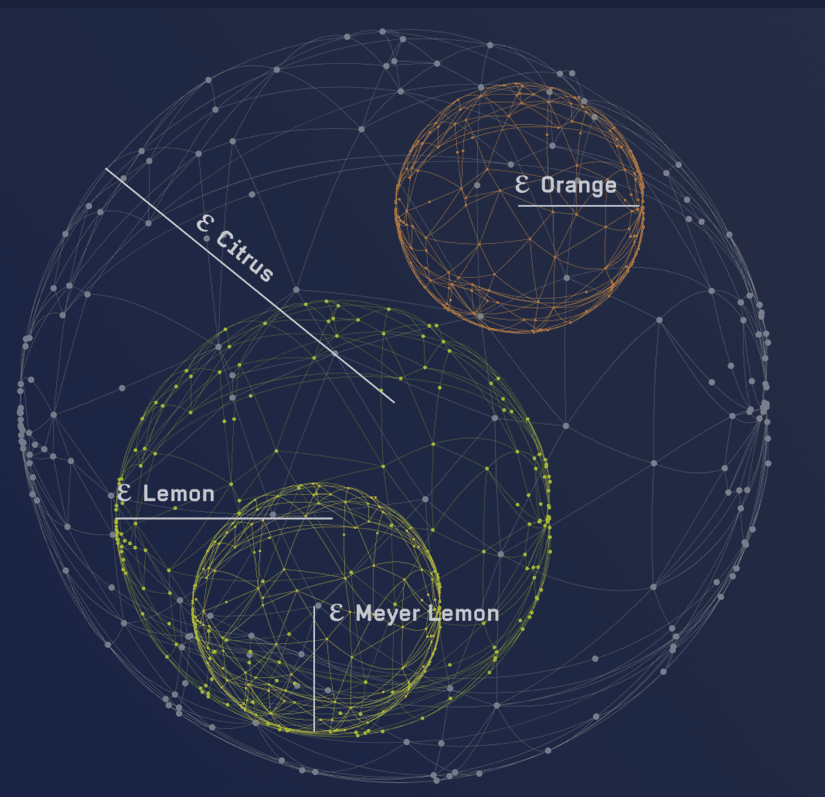Introduction
Artificial intelligence (AI) and machine-learning technologies are transforming the world as we know it, and are proving to be integral to advancements within the plant-based industry. There are a vast number of applications for AI and machine learning within the food industry, from supply-chain management to the optimisation of the manufacturing process.
In this article, we focus on the four key ways in which your company can utilize AI to improve your plant-based product-development process, helping to reduce company costs, promote productivity in your workforce, and truly excite consumers.
To harness the power of AI in the research and development (R&D) process, we recommend that you:
- Lead with consumer insight
- Drive innovation and reduce costs with AI-powered flavors
- Connect and collaborate with other companies
- Keep humans at the forefront
So, what can AI-powered technologies actually do for you?
Statistics by American data firm Nielsen tell us that 80–85% of all fast-moving consumer goods (FMCG) launches fail within two years.1 According to their white paper, ‘Setting the record straight on innovation failure’, the key reasons behind these launch failures include:
- Neglecting to address a broad consumer need
- Failing to provide a good product experience
- Providing insufficient marketing support
AI can help your business avoid all of these challenges by providing solutions designed by algorithms which can sift through millions of data points in a matter of seconds. This includes data on consumer preferences, future trends, flavor pairing and mimicking, cost constraints, as well as health and sustainability benefits.

When many of us think about AI, our first thought is of robots. But AI has many more applications besides this…
For plant-based businesses looking to develop tastier, healthier, and cheaper products in record time, AI can be instrumental. However, to get the most out of it, you need to know exactly what it is, how you can effectively implement it, and what sort of challenges might be involved. For example, are you looking to better understand consumer preferences, or are you more interested in creating new products which better mimic animal-based goods? The type of data you will need to implement machine-learning technology to solve these problems will differ vastly depending on your needs. This article will explore some of the central applications of AI, helping you to figure out at which stage in the R&D process your company could use them.
Read on to find out more about how best to integrate these technologies into your business, ultimately helping you to reduce costs, see your product launches succeed, and make plant-based products more enticing to everybody…
1. Lead with consumer insight
The top reason many FMCG products don’t succeed, according to Nielsen, is inadvertent failure to address a broad consumer need. Before your company starts any sort of production or prototyping, you need to identify a demand in the market that is currently not being met and lead with consumer preference in mind.
According to Josh Silverman, CEO of Aromyx, a biotechnology company specializing in the use of olfactory data and AI to develop targeted flavor solutions, there is currently a huge issue with R&D teams for plant-based brands developing products based on their personal taste preferences only. Once these products hit the market, they tend to suffer as consumers either don’t like the taste of the product as much as the company themselves did, or because the taste of the product has shifted during its time sitting on the supermarket shelf.

Be warned: time spent sitting on the shelf may affect the taste of your product once it reaches your target consumer.
To overcome this challenge and better appeal to consumer desires, companies typically invest more into consumer research. However, a lot of the data gathered from traditional consumer-research approaches are qualitative or subjective and can only go so far in helping your company to choose specific ingredients or model consumer trends before they happen. It can also be a lengthy and time-consuming process to sift through the data to target what consumers really want, especially if you are a small company or a start-up.
This is where AI comes in. With AI technology, plant-based businesses can sort through massive data sets that are able to identify patterns quickly and comprehensively, allowing businesses to make more thorough decisions with better outcomes.
For example, when we smell or taste, chemicals and receptors in our nose and tongue send signals to the brain, which then processes whether or not we like or dislike that experience. Modern machine-learning technology is able to quantifiably reproduce these measurements of taste and smell, and then predict which flavors might appeal to different types of consumers. This is the core of Aromyx’s proprietary technology and business model.
“There is no such thing as a universally good flavour,” Silverman explains. “We talk about an idealized average consumer, but this consumer doesn’t exist. With our technology, we can help our customers formulate products to a specific target consumer, keeping in mind what ingredients they will like, the ratio in which to use them, and so on.”
This is particularly important within the plant-based industry, where many food manufacturers are consistently trying to produce the best-tasting meat or dairy alternative. Having access to AI technologies, which can sift through enormous datasets of consumer preferences and predict exactly which tastes consumers enjoy from traditional animal-based products, is game-changing.
This technology also allows for increasingly accurate consumer-preference trend modeling, meaning companies can create products based on consumer preferences in specific geographic locations. If the plant-based industry really wants to compete against animal-based alternatives, getting specific with culture can be an enormous help.

It’s hard to imagine what millions of data points modeling consumer preference might look like. Luckily, with AI, you don’t have to.
Utilizing AI for this type of application will ultimately save your company time and money – knowing what consumers want will no longer be a guessing game, and the risk of having your plant-based products fail due to lack of consumer appeal will become a non-issue. This is especially true if you are able to mobilize the technology to predict future trends and develop products with this intel in mind.
However, even with consumer preferences in mind, you still need to make sure your product tastes good enough to keep consumers coming back for more. And AI can help with this as well.
2. Drive innovation and reduce costs with AI-powered flavors
Possibly the most exciting application of AI within the R&D process is its ability to match together ingredients, presenting food manufacturers with myriad flavor combinations based on the desired end product. Sifting through thousands of different ingredients and knowing their millions of separate properties was simply not a possibility when we were equipped only with human brain power.
AI-powered flavor company Gastrograph, for example, uses preference-mapping technology to analyze and interpret qualitative flavor descriptions by consumers and taste testers. According to their website, they have trained their algorithm “to understand flavors as layered signatures”.2

A flavor signature visualizing the relationship between different types of lemon and citrus flavors
In the past, it was necessary to simplify flavor because it was too time-consuming to analyze and draw meaningful insights from complex tasting data. Today there’s no excuse. The power of AI means our system can process a lot of information in a short time. We can gather nuanced and detailed tasting data and use our system to spot patterns and make predictions.”3
For the plant-based industry, this sort of advanced capability opens the door to even better flavor opportunities. It is particularly pertinent, considering that taste is the key driver for flexitarian consumers when purchasing plant-based products.4 It even addresses the second most common reason for product failure, according to Nielsen: failing to provide a good product experience.
Successful flavor matching combined with consumer-preference modeling is a game changer, explains Silverman from Aromyx. “If a [non-vegan] consumer walks through a supermarket aisle, and they pick a plant-based product off the shelf and they don’t like it, are they really going to try another one?”
By successfully targeting the right consumer demographic and perfecting the flavor of the product using AI, you are more likely to get it right the first time and see consumers coming back again and again for more.
For example, a company looking to mimic the taste of animal-based meat in a plant-based product could input this specification and be presented with a host of options for ingredients that would best achieve this. This is what Chilean plant-based food-tech company NotCo’s patented AI algorithm – known as Giuseppe – achieves.

Consumers might not know that AI is the technology behind their favorite product, but AI data modeling will ensure that the product is tailored to their tastes.
“We have a system that accelerates R&D and removes the need for trial and error,” says Aadit Patel, Head of Machine Learning and Engineering at NotCo. “The algorithm tells you which experiments to run and helps you to get interesting products with novel ingredients into the market much faster.”
In this regard, it is clear how using AI to develop flavors and aromas within products can help to streamline the process as a whole, freeing up creative capacity within your team and saving both time and money. This means the scientists and chefs on your team can spend less time worrying about how to achieve certain flavors and more time perfecting the other important elements of the product, as well as brainstorming new ideas from scratch.
However, AI can go even further in helping to reduce costs for both you and your customers. For example, using machine learning algorithms means you can plug in not just ideal flavor goals, but also end-product price. This is key as, next to taste, cost is often a common barrier for consumers wanting to buy more plant-based products.5
Other specifications can also be added, such as sugar, fat, or calorie content, and so forth. This means businesses can quickly develop products to tap into consumer trends for increased health, without having to spend hours experimenting in the food lab. In other words, the ability to input constraints such as cost and nutrition can benefit both you and your consumers.
NotCo, for example, is able to produce a working prototype of a product in just a matter of weeks. “Once you have the consumer data, you can go from idea to prototype in a much shorter period of time,” Patel elaborates. “You can then adapt this to your customers’ preferences and tweak it to make it perfect.”
As such, we recommend you embrace the benefits of AI to really drive flavor innovation in this space. By producing better-tasting products at a lower cost for you and your target consumer, the plant-based sector will only continue to grow, becoming more accessible while also challenging its animal-based counterparts which consistently promote an alleged narrative of better tastes at cheaper prices.
3. Connect and collaborate with other companies
Of course, building out machine-learning platforms – which necessitate huge data servers – is costly and largely inaccessible to smaller plant-based companies. That’s why we recommend finding companies who do have this capacity and collaborating with them.
Above all else, AI outputs are only as powerful as the input data, so it is important to work with businesses that are able to access and wrangle the most accurate data. This is especially true in the case of consumer preference and trend modeling.
According to Silverman, the data that would be necessary to truly accelerate the capabilities of AI in this space are currently unavailable. While retail data from sources like Nielsen and IRI can be helpful, they don’t typically capture the local differences in taste and aroma preference. Similarly, although the technology allows for the specifying of various different constraints (such as price), solutions will not appear out of thin air. If cheaper ingredients don’t exist in the database, for example, the AI will not necessarily produce a cheaper solution.

Go all-in for collaboration with other firms and see your realm of possibilities expand.
Many private companies are mobilizing their private data servers to provide smaller businesses with more options. In 2019, flavor company McCormick announced its collaboration with research firm IBM, paving the way for advancements in the field of AI and flavor development.6 In 2020, ingredients company Firmenich announced the creation of the “world’s first” AI-designed flavor, having input “parameters of 100% natural beef taste” into their algorithm for use in plant-based meat analogs.7 Givaudan also revealed their ‘Advanced Tools for Modelling’ (ATOM) system in 2021, citing a desire to streamline end-to-end product creation by providing faster and more effective ingredient solutions for their clients.8 A recent partnership between Kraft Heinz and NotCo also demonstrates the power of collaboration of this kind, combining NotCo’s patented AI technology with Kraft Heinz’s brand portfolio and manufacturing capabilities to develop better plant-based products at greater speed and scale.9
If you are looking to step up your plant-based business and accelerate the sector as a whole, collaborations are a key way to do this. This is especially true if you already have a strong brand identity with a loyal customer base, as your well-established position in the market could be leveraged in conversations with bigger ingredients firms or manufacturers that have the capital and scaling capabilities to really make the most out of AI technology.
4. Keep humans at the forefront
Finally, no one can deny that food is a human experience. Even with the AI technology in place, your business should reflect the importance of humans throughout the production process – from those who nurture the beginnings of a product idea to those who consume it at the end.
While machine-learning technology affords new opportunities that would not have been possible with just human brain power, this technology works best in collaboration with its human counterparts – especially if everyone within the company is trained on how best to use it. Take time as a company to understand all the applications of the technology, and even look at hiring people whose job it is to smoothly integrate AI among your chefs and scientists. So far this has been the approach of NotCo, which aims to make the technology a facilitator for producing great, plant-based food.
If using AI is the route you decide to go with to help craft your plant-based products, don’t let it overshadow the importance of your other team members. Food scientists and chefs still have a major role to play in nurturing ideas, in taste testing, in perfecting the texture and look of a product, and in managing its overall development right until it meets the consumers on the supermarket shelf. AI is here to make their job easier, not to make it redundant.

AI can help free up time for your employees, especially your chefs and food scientists, who can use the time to brainstorm even more new and exciting products and recipes.
“We’re not replacing the necessity of chefs or food scientists,” Patel emphasizes. “The AI system is an augmentative tool that accelerates our R&D capabilities. Food is a human experience at the end of the day.”
To achieve your company’s net-zero targets and to promote the adoption of plant-based diets globally, everyone in your business needs to be on board and aware of how this technology can help them in their role. For more insight into other key organizational changes your businesses can make to drive sustainability, click here to read the New Food Hub’s full article.
Key takeaways
There are many benefits to implementing AI technology within your company’s R&D phase. These include the ability to better leverage consumer data and predict future trends, the power to innovate new and exciting flavors and aromas, and the ability to effectively manage the end product from early on within development, for example with the inputting of cost and nutritional constraints. All in all, this means your company will be able to create better products for a cheaper price, ensure consumers come back for more, and help the plant-based sector to reach its true potential.
To get the most out of these exciting applications, we recommend that you:
- Lead with consumer insight
- Drive innovation and reduce costs with AI-powered flavors
- Connect and collaborate with other companies
- Keep humans at the forefront
Machine-learning technology in combination with other exciting innovations – such as cellular agriculture and precision fermentation – spell an exciting future for the plant-based industry. And this is before we even get into the benefits of AI in the manufacturing process itself, such as the optimisation of supply-chain management and cleaning processes, as well as the reduction of machine error.
Make sure to sign up to ProVeg’s New Food Hub for more on these topics and never miss a trick. If you’d like to work with us in developing your plant-based strategy, you can also email us at [email protected].
References
- The Nielsen Company (2018): Setting the record straight on innovation failure. Available at: https://www.nielsen.com/wp-content/uploads/sites/3/2019/04/setting-the-record-straight-common-causes-of-innovation-failure-1.pdf Accessed 2022-08-23.
- Cohen, J. (2022): Why Conventional Product Testing Gets Flavor So Wrong. Gastrograph. Available at: https://www.gastrograph.com/blogs/why-conventional-product-testing-gets-flavor-so-wrong Accessed 2022-08-25.
- Cohen, J. (2022): Why Conventional Product Testing Gets Flavor So Wrong. Gastrograph. Available at: https://www.gastrograph.com/blogs/why-conventional-product-testing-gets-flavor-so-wrong Accessed 2022-08-25.
- Smart Protein Project (2021): ‘What consumers want: A survey on European consumer attitudes towards plant-based foods. Country-specific insights’ European Union’s Horizon 2020 research and innovation program (No 862957). Available at: https://smartproteinproject.eu/consumer-attitudes-plant-based-food-report/ Accessed 2022-07-26.
- Smart Protein Project (2021): ‘What consumers want: A survey on European consumer attitudes towards plant-based foods. Country-specific insights’ European Union’s Horizon 2020 research and innovation program (No 862957). Available at: https://smartproteinproject.eu/consumer-attitudes-plant-based-food-report/ Accessed 2022-07-26.
- IBM Newsroom (2019): McCormick & Company and IBM Announce Collaboration Pioneering the Use of Artificial Intelligence in Flavor and Food Product Development. Available at: https://newsroom.ibm.com/2019-02-04-McCormick-Company-and-IBM-Announce-Collaboration-Pioneering-the-Use-of-Artificial-Intelligence-in-Flavor-and-Food-Product-Development Accessed 2022-08-19.
- Firmenich (2020): The World’s First AI-Created Flavor. Available at: https://www.firmenich.com/taste-and-beyond/blog-article/worlds-first-ai-created-flavor Acessed 2022-07-08.
- Givaudan (2021): Givaudan launches ground-breaking AI tools for next generation product development. Available at: https://www.givaudan.com/media/trade-media/2021/givaudan-launches-ground-breaking-ai-tools-next-generation-product Accessed 2022-07-08.
- The Kraft Heinz Company (2022): Not Your Average Joint Venture: Kraft Heinz and TheNotCompany Create Partnership to Accelerate AI-Driven Plant-Based Innovation Globally. Available at: https://ir.kraftheinzcompany.com/news-releases/news-release-details/not-your-average-joint-venture-kraft-heinz-and-thenotcompany Accessed 2022-07-08.



